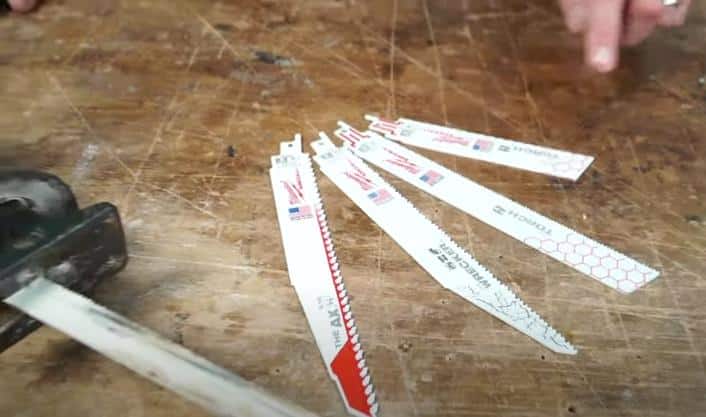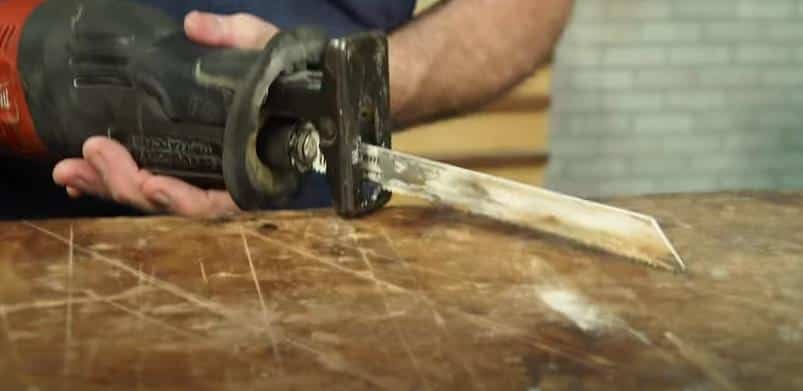Use a guide to ensure a straight cut.
A reciprocating saw is a versatile tool that can quickly complete numerous cutting jobs. However, it can be difficult to achieve straight cuts with this tool. So, knowing how to cut straight with a reciprocating saw is essential to save time and frustration.
Straight cutting with a reciprocating saw may appear complicated, but it can be a breeze with the right skills and tools. Consider being able to make perfect cuts on your DIY projects with no aggravation or waste. You can make straight cuts in different materials if you choose the right blade, mark your cut, and keep control of your saw.
However, this guide will cover various tricks and tactics for creating precise, straight cuts with your reciprocating saw. This article will also help you get the most out of your equipment and get exceptional results on your cutting jobs, from selecting the perfect blade to maintaining proper technique.
How To Cut Straight With A Reciprocating Saw?

If you’re looking for a quick and easy way to cut through materials like wood, metal, or plastic, a reciprocating saw is the tool for you. But getting a straight, clean cut can be tricky if you’ve never used one.
Here’s a step-by-step guide to help you get the perfect cut every time.
- Choose the right blade. You’ll need to use a different blade depending on the material you’re cutting. For example, if you’re cutting wood, you’ll need a blade with teeth that are spaced further apart.
- Set the blade to the correct depth. If the blade is too shallow, it will bind in the material and you won’t be able to make a clean cut. If the blade is too deep, it will cause the saw to kick back, which can be dangerous.
- Clamp the material down. This will help to keep it from moving while you’re cutting.
- Use a slow, steady motion. Don’t try to force the saw through the material. Let the blade do the work.
- Make multiple passes. If you’re cutting through a thick piece of material, you may need to make several passes with the saw to get through.
Following these steps will help you get a straight, clean cut every time you use a reciprocating saw.
Related: What kind of jigsaw blade to cut vinyl plank flooring
How To Properly Hold A Reciprocating Saw For Cutting Straight?
To cut straight with a reciprocating saw, hold the saw so that the blade is perpendicular to the work surface.
- First, ensure your blade is the right size and type for the job.
- Clamp the material you are cutting down so it cannot move.
- Now, it is time to start the saw. Firmly grip the saw with both hands and position the blade at the start of the cut line.
- Slowly and steadily push the saw forward, following the cut line. Do not force the saw or try to cut too quickly.
- Once the blade has made it through the material, stop the saw and let it come to a complete stop before moving it away from the cut.
What Is The Best Blade To Use For Cutting Straight With A Reciprocating Saw?
A metal cutting blade is best for cutting straight with a reciprocating saw.

Many options are available when it comes to cutting straight with a reciprocating-saw. Let’s look at a few examples.
One option is the Milwaukee 48-22-5200 12-Inch Sawzall Blade. This blade is 12 inches long and 1 inch wide, making it a good choice for cutting through thick materials. It has 24 teeth per inch so that it will cut quickly, but it’s not recommended for use on delicate materials.
Another option is the Dewalt DW4856 6-1/2-Inch Circular Saw Blade. This blade is 6-1/2 inches in diameter and has 48 teeth, making it a good choice for cutting through thick and thin materials.
Finally, the Makita B-63597 6-1/2-Inch TCT Saw Blade is a good all-purpose blade. It’s 6-1/2 inches in diameter and has 60 teeth, making it ideal for cutting through various materials.
Consider Factors When Choose A Reciprocating Saw:
If you’re looking for a reciprocating saw that can cut straight, you’ll want to consider the following factors:
- The length of the blade: A longer blade will give you more cutting power but will also be more difficult to control.
- The width of the blade: A wider blade will also give you more cutting power, but it will be more likely to wander off course.
- The teeth on the blade: A blade with more teeth will cut more quickly but produce a rougher cut.
- The type of material you’re cutting: Some materials, like metal, require a different blade type than others.
- Your preference: Ultimately, the best blade to use for cutting straight with a reciprocating saw is the one you’re most comfortable with.
How To Set Up The Reciprocating Saw For Cutting Straight?
To cut straight with a reciprocating saw, use a blade designed for that purpose and hold the saw steady against the workpiece.
Cutting straight with a reciprocating saw can be tricky, but with a little practice it is possible to get clean, precise cuts.
Here are a few tips to help you get started:
- Start by clamping the workpiece securely to a work surface. This will help prevent the workpiece from moving around while cutting.
- Next, select the correct blade for the material you are cutting. A carbide-tipped blade will work well for most common materials.
- Put the blade on the saw, ensuring it is on the right and the teeth are facing the right way.
- Once the blade is installed, turn on the saw and let it come up to full speed before beginning to cut.
- When you are ready to start cutting, slowly lower the blade into the workpiece. Be careful not to push too hard, or you may end up with a less than straight cut.
- Keep the blade moving steadily as you cut through the workpiece. If you need to make a turn, slow down the saw before making the turn.
- When you are finished cutting, turn off the saw and allow the blade to come to a complete stop before removing it from the workpiece.
- Use a file or sandpaper to smooth any rough edges.
With a little practice, you should be able to cut straight with a reciprocating saw. Just take your time and be careful, and you should be able to get great results.
When Cutting Straight With A Reciprocating Saw, How Do I Make Sure The Blade Is Perpendicular?
Use a speed square or a T-square to align the blade with the workpiece.

If you’re using a reciprocating saw for a straight cut, you must ensure the blade is perpendicular to the workpiece.
Here’s how to do it:
- Place the workpiece on a stable surface.
- Position the saw so that the blade is perpendicular to the workpiece.
- Start the saw and let it run for a few seconds to ensure it runs smoothly.
- Slowly guide the blade into the workpiece, keeping the blade perpendicular.
- Cut through the workpiece and then release the trigger.
- Let the saw come to a stop before setting it down.
Here’s a quick tip: if you’re having trouble keeping the blade perpendicular, use a guide. You can either use a straightedge or a piece of scrap wood to help guide the blade.
How To Make A Straight Cut With A Reciprocating Saw Without A Guide?
Mark your cut line with a pencil, then line up the blade of the saw with the line.
If you’re not careful, a reciprocating saw can create a wavy rather than straight cut. You’ll need to use a guide to make a straight cut with a reciprocating saw.
Here’s how:
- Measure and mark your cutline. Use a pencil to ensure that the line is visible.
- Attach the guide to your saw. Most guides have a clamp that attaches to the saw’s shoe (the metal baseplate at the bottom of the saw).
- Line up the blade with the cutline and start the saw.
- Keep the blade pressed against the guide as you cut. Don’t force the saw; let the blade do the work.
- Turn off the saw and unclamp the guide when you’re done.
Here’s a tip: For a straight cut, use a piece of masking tape or painter’s tape along the cutline as an additional guide.
FAQ
What Are Some Tips For Cutting Straight With A Reciprocating Saw?
There are a few things you can do to cut straight with a reciprocating saw:
1. Use a guide: Attach a straight edge or a level to your workpiece to act as a guide for the saw. This will help you keep the blade on track and produce a straighter cut.
2. Use a slower speed: If you can, adjust the speed of the saw to a lower setting. This will help you have more control over the blade and produce a cleaner, straighter cut.
3. Go slowly and steadily: Take your time when cutting and don’t rush it. Be sure to guide the saw steadily along the guide so that it doesn’t veer off course.
How To Troubleshoot Issues With Cutting Straight With A Reciprocating Saw?
If you’re having trouble cutting straight with a reciprocating saw, you can try a few things. First, ensure that the blade you’re using is sharp and that the teeth face the correct direction. The saw won’t cut straight if the blade is dull or the teeth face the wrong direction.
Another thing to check is the guide. Some reciprocating saws have a guide that helps keep the blade straight, but it won’t work properly if the guide is loose or damaged.
Finally, if you’re still having trouble, you can use a different blade or type of saw. If you’re using a standard blade, try a demolition blade. If you’re using a cordless saw, try a corded saw. Sometimes, a different blade or saw will work better for a particular application.
How To Fix A Mistake When Cutting Straight With A Reciprocating Saw?
If you’re cutting with a reciprocating saw and you make a mistake, you can use a few different techniques to fix it. One way is to use a hammer and chisel to chisel out the mistake. Another way is to use a hand saw to cut through the mistake.
What Are Some Common Mistakes When Cutting Straight With A Reciprocating Saw?
There are a few common mistakes when cutting straight with a reciprocating saw. The first is not using a guide. Without a guide, it is difficult to keep the saw blade on a straight path, which can result in a curved or wavy cut. Second, people often try to cut too quickly, which can cause the blade to bind and kick back. This can be dangerous and damage the material being cut. Finally, not using the proper blade can also lead to poor cuts. Using a blade that is too small can cause it to overheat while using a blade that is too large can cause it to vibrate and produce a poor cut
Wrap Up
With practice, cutting straight with a reciprocating saw is a technique that can be learned and mastered. You can produce precise cuts on many materials by following the steps I’ve provided. Always prioritize safety by wearing appropriate gear and operating your saw with caution.
You can achieve straight, clean cuts on your projects and take your DIY talents to the next level with a bit of patience and dedication.
Thus, don’t be scared to experiment and try out new approaches – the possibilities cut straight with a reciprocating saw are limitless.

